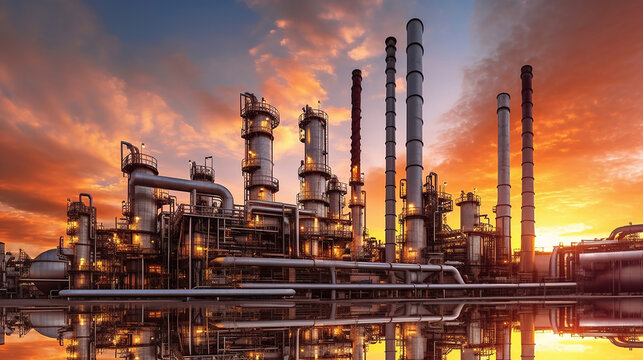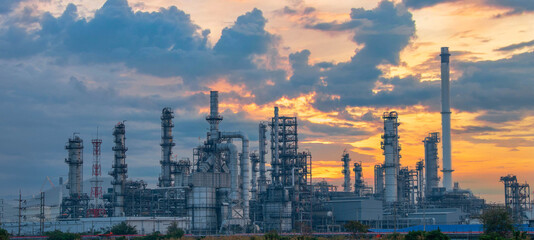Refinery Equipment: The Core Technology of Modern Refineries
The Importance of Oil Refinery
Oil Refinery plays an important role in the petroleum industry. Modern refineries convert crude oil into a variety of valuable products such as gasoline, diesel, jet fuel and lubricants through complex chemical and physical processes.
The refining process consists primarily of the steps of distillation, cracking, reforming and desulfurization. Crude oil is first passed through distillation towers for initial separation, and then through the cracking process to break up large molecules and produce lighter products. The reforming process further enhances product quality, while the desulfurization process removes harmful impurities.
Oil refinery equipment includes distillation columns, reactors, heat exchangers and storage tanks, each of which plays an important role in the refining process. As environmental awareness grows, refineries are moving toward going green, adopting cleaner technologies and equipment, such as hydrogen energy and carbon capture, to reduce pollutant emissions and carbon footprints. Going green not only improves productivity, but also promotes sustainable energy use, providing a win-win solution for both environmental protection and economic development.

The History of Oil Refinery
The history of oil refining dates back to ancient times, but modern refining technology began in the mid-19th century.In 1859, Edwin Drake of the United States successfully drilled the first oil well in the modern sense in Pennsylvania, marking the beginning of the oil industry. Initially, oil was mainly used to produce kerosene to replace whale oil as a lighting fuel. However, with the invention of the internal combustion engine and the rise of the automobile industry, the demand for products such as gasoline and diesel fuel increased rapidly.
Early refineries were poorly equipped and mainly used simple distillation to separate crude oil into different fractions. in the early 20th century, with the development of chemical engineering and catalytic technology, new technologies such as catalytic cracking and catalytic reforming were introduced, which greatly improved refining efficiency and product quality. During World War II, the demand for synthetic fuels and high-octane gasoline drove further advances in refining technology.
In the 21st century, environmental protection and energy security issues have become important challenges for the refining industry. Modern refineries not only need to produce high quality fuels, but also need to reduce pollutant emissions and improve energy efficiency. The application of advanced catalysts, new separation technologies, as well as digital and automated control systems make the refining process more efficient and environmentally friendly.

The Operation Process of Oil Refinery
The operation process of oil refinery includes the following main steps: First, crude oil is transported to the refinery through pipelines or tankers. Next, the crude oil undergoes pre-treatment to remove salts, water, and impurities, then enters the atmospheric distillation column for initial separation, producing naphtha, diesel, and heavy oil. The next step is further processing these initial products: naphtha undergoes catalytic reforming to generate high-octane gasoline and aromatics, while diesel and heavy oil are converted into lighter oil products through hydrocracking and catalytic cracking. Finally, the various finished products are subjected to blending, desulfurization, and denitrification processes to meet quality standards before storage and transportation.
Oil Refinery Operation Process Table
| Step | Main Process | Products |
|---|---|---|
| Crude Oil Pre-treatment | Desalting, Dehydration, Impurity Removal | Purified Crude Oil |
| Atmospheric Distillation | Distillation Separation | Naphtha, Diesel, Heavy Oil |
| Catalytic Reforming | Catalytic Reforming | High-Octane Gasoline, Aromatics |
| Hydrocracking | Hydrocracking | Light Oil Products |
| Catalytic Cracking | Catalytic Cracking | Light Oil Products |
| Refining | Blending, Desulfurization, Denitrification | Qualified Finished Oil |
| Storage and Transportation | Storage, Transportation | Finished Oil |
What Equipment is Necessary for a Large Oil Refinery?
Large oil refinery requires complex equipment to process and convert crude oil into a variety of petroleum products. This oil refinery equipment includes crude oil distillation towers, hydrogenation units, cracking units, desulfurization units, hydrocracking units, catalytic cracking units, reforming units, sulfur recovery units, and exhaust gas treatment systems.
First, the crude oil distillation tower is the core equipment of the refinery, which separates crude oil into fractions with different boiling point ranges through heating and distillation. Next come the hydrogenation units and hydrocrackers, which use hydrogen to convert heavy oils into lighter, more valuable products and remove impurities such as sulfur and nitrogen. Catalytic cracking units and reformers are used to further process these fractions to produce gasoline, diesel and other petrochemical products.
Desulfurization units and sulfur recovery units are environmentally friendly equipment designed to reduce sulfur emissions from the refining process. The desulfurization unit removes sulfur compounds from crude oil through a chemical reaction, while the sulfur recovery unit converts these sulfur compounds into a saleable sulfur product. In addition, exhaust treatment systems reduce harmful emissions through filtration and chemical treatment to ensure compliance with environmental regulations.
In addition, large oil refineries require a range of auxiliary equipment and facilities, such as heat exchangers, boilers, compressors, pumps, storage tanks, piping systems and automated control systems. This equipment ensures efficient, safe and continuous operation of the refining process.

The Importance of Using Oil Refinery Equipment
Oil refinery equipment can effectively improve the utilization of crude oil. Through a series of complex chemical and physical processes, these equipments convert crude oil into a variety of valuable petroleum products, such as gasoline, diesel, lubricants and petrochemicals, minimizing waste and enhancing economic efficiency.
Oil refinery equipmenthelps to improve product quality and safety. Advances in modern refining technology enable the equipment to control reaction conditions more precisely, thus producing high-purity, high-quality products. This not only meets the market demand for high-quality petroleum products, but also improves the safety of the products and reduces the risks in the use process.
The use of advanced oil refinery equipment also significantly reduces environmental pollution. Modern equipment is usually equipped with a variety of environmental protection facilities, such as exhaust gas treatment systems and wastewater treatment devices, which can effectively reduce the emission of pollutants generated during the refining process and protect the environment.
The automation and intelligent development of oil refinery equipment has also greatly improved production efficiency and operational safety. Automated equipment reduces human errors in operation, and intelligent systems can monitor and adjust production parameters in real time to ensure that the equipment operates in the best condition.
Green Refining and Sustainable Development
Green refining and sustainable development is an important direction of current social development. Green refining technology realizes a win-win situation for both environmental protection and economic benefits by reducing energy consumption and waste emissions and improving resource utilization efficiency. It includes measures such as the use of renewable energy, the development of low-carbon emission processes and the recycling of waste to reduce the negative impact on the environment. Sustainable development emphasizes meeting the needs of the present without compromising the ability of future generations to meet their needs. By advancing green refining technologies and promoting the coordinated development of the economy, society and the environment, we can not only meet the challenges of resource depletion and environmental pollution, but also promote economic growth and realize the harmonious coexistence of man and nature.

FAQs
Q1:What are the main components of oil refinery equipment?
The main components include distillation columns, heaters, reactors, heat exchangers, pumps, pipelines, and control systems. Each component has specific functions such as separation, heating, reaction, and transfer.
Q2: How much does oil refinery equipment cost?
The cost of oil refinery equipment varies widely depending on the size and complexity of the refinery. A small, simple refinery might cost tens of millions of dollars, while a large, complex refinery can cost several billion dollars. Factors such as the type of crude oil processed, the range of products produced, and environmental regulations also impact the overall cost.
Q3: How do I choose the right oil refinery equipment?
Selecting the right equipment involves considering multiple factors, including the type of crude oil, the desired refined products, production capacity, technical parameters of the equipment, energy efficiency, and cost. It is usually necessary to have detailed discussions and planning with equipment suppliers or professional engineers.
Q4: What are the main safety hazards in the oil refining process?
Major safety hazards include high temperature and high-pressure operations, leaks of flammable and explosive substances, emissions of harmful gases, and equipment failures leading to fires and explosions. Strict adherence to safety operating procedures, regular safety inspections and training, and ensuring emergency response measures are in place are crucial.
Q5: How important are environmental protection measures in the oil refining process?
Environmental protection measures are very important, including the treatment and control of emissions, wastewater, and solid waste. Advanced environmental technologies and equipment should be used to minimize the environmental impact of the refining process, and compliance with relevant environmental laws and regulations is essential.






